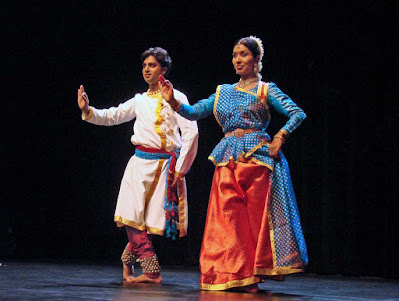kathak
The name itself is derived from the Sanskrit word – Katha (Story). The narrator of a story is called Katthaka in Sanskrit. Hence this dance form which narrates a story through the expressions and body movements came to be called Kathak.
The dance form of Kathak has three main schools which have their own unique style and instruments. The schools known as Gharanas are Lucknow Gharana, Banaras Gharana and Jaipur Gharana.
The first two Gharanas are the ones from Uttar Pradesh. The Lucknow Gharana has a lot of Mughal influence reflected in it. The Banaras Gharana showcases a lot of use of the dance floor, not only for movement of the feet but also a flop down movement which shows the danseuse hugging the floor.
Kathak is one of the eight major forms of Indian classical dance. The origin of Kathak is traditionally attributed to the traveling bards of ancient northen india known as Kathakars or storytellers.The term Kathak is derived from the Vedic sanskrit word Katha which means "story", and Kathakar which means "the one who tells a story", or "to do with stories". Wandering Kathakars communicated stories from the great epics and ancient mythology through dance, songs and music.Kathak dancers tell various stories through their hand movements and extensive footwork, their body movements and flexibility but most importantly through their facial expressions. Kathak evolved during the bhakti movement , particularly by incorporating the childhood and stories of the Hindu god Krishna , as well as independently in the courts of north Indian kingdoms. Kathak is unique in having both Hindu and Muslim Gharanas and cultural elements.Kathak performances include Urdu Ghazals and commonly use instruments brought during Muslim Rules Kathak is found in three distinct forms, called "gharanas", named after the cities where the Kathak dance tradition evolved – Jaipur , Banaras and Lucknow.While the Jaipur gharana focuses more on the foot movements, the Banaras and Lucknow gharanas focus more on facial expressions and graceful hand movements. Stylistically, the Kathak dance form emphasizes rhythmic foot movements, adorned with small bells (Ghugruss), and the movement harmonized to the music.The legs and torso are generally straight, and the story is told through a developed vocabulary based on the gestures of arms and upper body movement, facial expressions, neck movements, eyes and eyebrow movement , stage movements, bends and turns. The main focus of the dance becomes the eyes and the foot movements. The eyes work as a medium of communication of the story the dancer is trying to communicate. With the eyebrows the dancer gives various facial expressions. The difference between the sub-traditions is the relative emphasis between acting versus footwork, with Lucknow style emphasizing acting and Jaipur style famed for its spectacular footwork.
Kathak as a performance art has survived and thrived as an Oral Traditional , innovated and taught and from one generation to another verbally and through practice. It transitioned, adapted and integrated the tastes of the Mughal courts in the 16th and 17th centuries, particularly by Akbar , and was ridiculed and declined in the colonial British era, then was reborn as India gained independence and sought to rediscover its ancient roots and a sense of national identity through the arts.


No comments:
Post a Comment